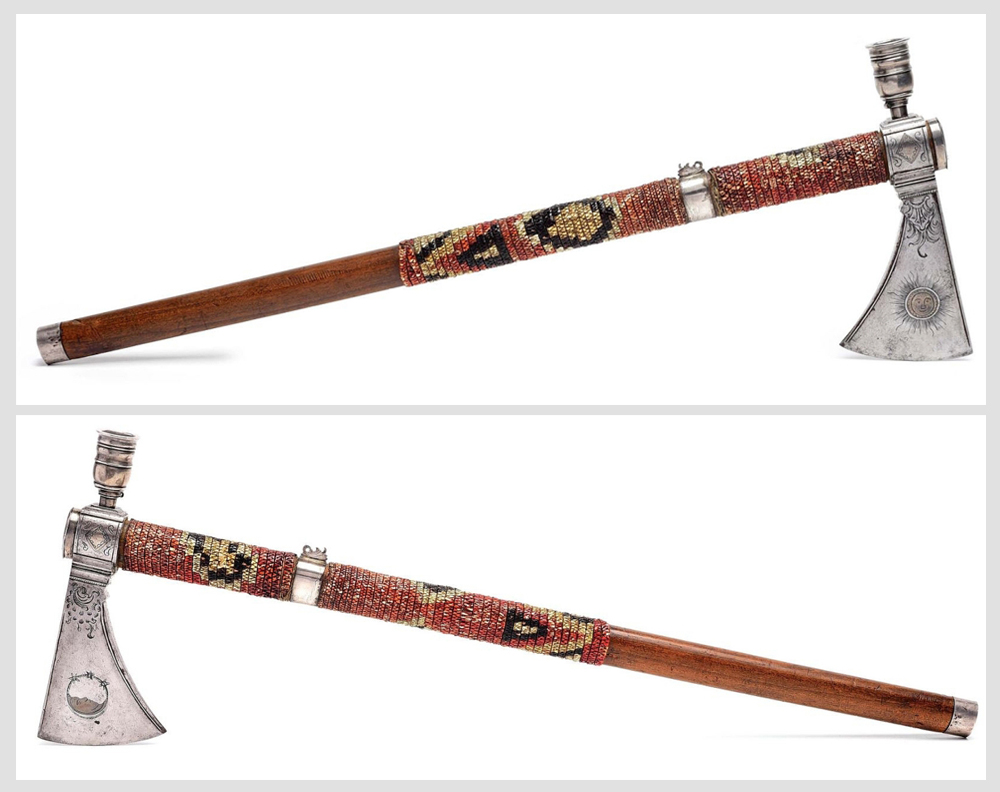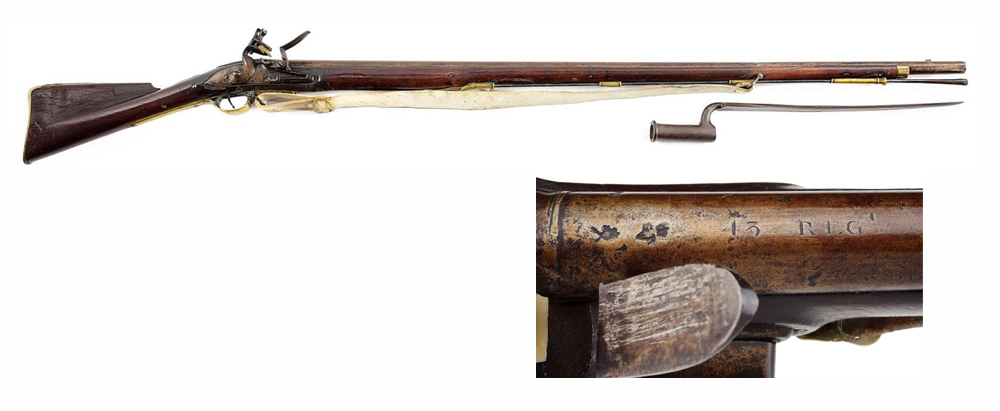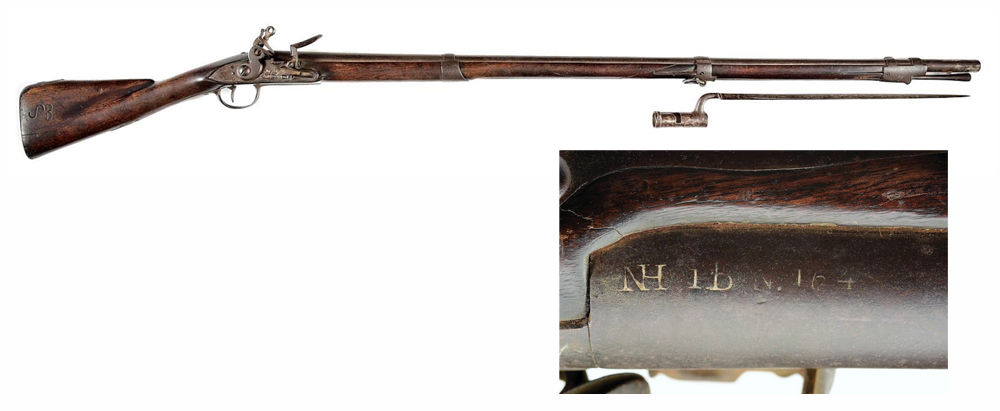
A new record for any tomahawk sold at auction was set at $664,900 for the Butler tomahawk at Morphy Auctions’ May 27 Founders & Patriots sale. The example was made by future-General Richard Butler when he was an armorer at Fort Pitt from 1765 to 1770. He made it for Lieutenant John McClellan. Both of their names are inscribed on the tomahawk, which is a rare occurrence. Sale specialist David Geiger knows of no other works signed by Richard Butler, even though he certainly produced a sizable amount during his career. Geiger called it the most attractive tomahawk in existence. It over quadrupled the previous record for any tomahawk at auction, which was set in 2006 with an example from the Guthman collection. It sold to an American collector.
Review by Greg Smith, Photos Courtesy Morphy Auctions
DENVER, PENN. – Three days of auctions May 27-29 featuring 920 lots of firearms and militaria through time produced $8.4 million in total sales at Morphy Auctions.
“Any question as to the strength of the market for rare firearms and important militaria was resolved by the end of our sale,” said Morphy Auctions founder and president Dan Morphy. “From our vantage point, we could see just how strong the hobby is right now. In addition to advanced collectors who went for the very rare and unique pieces, there were many enthusiastic new collectors who were guided by our experts’ meticulously detailed catalog descriptions. At every level, buyers were thrilled with their purchases.”
Day one, which produced $2 million and went 88 percent sold, was the Founders and Patriots auction, led by 210 lots of historic firearms and militaria, documents, artwork and rare imprints from the American Revolution era and the War of 1812. It is one of two sales each year that arms and armor specialist David Geiger puts together at Morphy Auctions. This was the first sale on board with specialist James Kochan, who will provide expertise going ahead on books, manuscripts, paintings and uniforms for the department. The two worked together to produce a thoroughly well-documented and researched catalog that places each lot within the broader context of history and its storied battles and figures.
A total of 72 phone bids were logged and 214 bidders were signed in bidding online.
The sale featured one of the most robust tomahawk offerings to come to auction in decades. Two of the tomahawks offered bested the auction record for any example to that date, which was, we believe, set at $150,000 for one that sold from the Bill Guthman collection in 2006. The new record holder, the Butler tomahawk, raised the mark over four-fold to $664,900, selling to a private American buyer. When the bidding started 19 lots into the sale, competing left bids had pushed it above the record before Dan Morphy said a single word. The firm had six phone bidders on the lot and there was no holding back – it was knocked down within two minutes of fast bidding.

This tomahawk was presented by French King Louis XV to the Indian Chief Allies of the French in North America during the Seven Years War. There are eight examples known, with five of them in museums. It is now the second highest selling tomahawk at auction as it took $168,000 after 25 bids. The piece is dated 1760 and features an original haft and detailed engraving to the axe, with symbols that include a crescent moon, a star, a fleur-de-lis, a drum, cannon, cannon balls and a sun in splendor.
“It is the most attractive tomahawk in existence because of the Shawnee quillwork on the haft,” Geiger told us. The firm cataloged the Butler tomahawk as a maple haft with two sections of period Shawnee porcupine quill work in red, black and white dyes. The hand forged head features a silver bowl and is engraved to both sides: one with a “shell design at the top and an engraved sun in splendor with a silver engraved inlay as the center, the other side shows an engraved inlaid half moon with a face surrounded by other engraved designs.”
“But on top of that,” Geiger said, “it is a very historic tomahawk, inscribed to McClellan and signed by future General Richard Butler. We know who made it and who it was made for.”
That is notable, according to Geiger, as tomahawks were rarely inscribed as such. Even though he worked on and produced a quantity of weapons at Fort Pitt, Geiger knows of no others works that are signed by Richard Butler.
Butler moved to America from Ireland with his family. His father was a gunsmith who first settled in Lancaster, Penn., and then in Carlisle, Penn., offering his gunsmithing services in a building that still stands today. Butler became an armorer at Fort Pitt from 1765 to 1770. The Carnegie Library holds his log book from this time, where his production of other tomahawks and rifles is documented.
Throughout his military career, Butler rose in rank until he was promoted to Brevet Brigadier General in 1783 at the conclusion of the Revolutionary War. He had fought at Saratoga, Stony Point and Yorktown.
Butler was a Native American relations specialist. He negotiated the Treaty of Neutrality with the Shawnee and Delaware Native Americans in 1776, the Treaty of Fort McIntosh in 1785 and the Treaty of Fort Finney in 1786. He died in 1791 at the hands of Native Americans at St Clair’s defeat.

Matching an auction record for a regiment- marked Brown Bess was this example, one of three known from the 43rd Regiment of Foot who fought in the Revolutionary War for the British. It sold for $73,800 and was the highest selling musket in the sale.
Lieutenant John McClellan, for whom the tomahawk was made, was a First Lieutenant in Company D of Thompson’s Battalion of Pennsylvania Rifleman. The company marched from Carlisle, Penn., to Boston, where it was detached and put under the command of Benedict Arnold. McClellan would die following the capsizing of a small boat on a river as he marched from Boston to the Battle of Quebec. His brother took the tomahawk up to the battle, where he was taken prisoner and it was plundered by a British officer. From there, the tomahawk made its way back to England.
Geiger said that the unbroken chain of ownership on this example added a great deal of value to it.
“We know it was recorded in England as a war trophy shortly after,” he said. It was bought by George Greville, the Earl of Warwick for his arms collection at Warwick Castle, where it remained for more than 200 years. At one point, it went on display at the Tower of London. It has since been on display at the Smithsonian, the Heinz History Center and the Canadian War Museum. It is featured in four publications.
In 1997, the Butler tomahawk was sold at Sotheby’s New York and was purchased by Dave Kleiner, who sold it to Gordon Barlow, who sold it to Kelly Kinzle, who placed it into a collection.
Geiger said that the three tomahawks at the top of this sale are, in his opinion, among the top ten tomahawks in existence.
The second highest selling tomahawk at auction is now held by a $168,000 result for a dated 1760 example that was presented as a gift from French King Louis XV to the Indian Chief Allies of the French in North America during the Seven Years War.

Selling for $60,000 was this pair of silver-mounted pistols, one of only a few associated with George Washington. These were given by Washington to Captain James Chambers, whose family they descended in until 2010.
Geiger said the workmanship is remarkable, noting the gadrooned brass overlay to the bowl and the detail to the blade. He wrote of it, “The right side is engraved with a crescent moon, a star, a fleur-de-lis, a drum, cannon and cannon balls, along with decorative borders. The left side features ornate borders, a fleur-de-lis and a sun in splendor with a silver inlaid circular center engraved with a face.” It features its original haft, brass inlay and is inscribed “A R.”
It was surfaced by an English picker in the 1960s who sent it to American dealer Glode Requa. Past owners of it include Walter O’Connor, Bill Grimmison, Dave Kleiner, Marvin Lince, and the same unnamed collector who owned the Butler tomahawk. Morphy handled and sold this example once before a few years ago.
The third example, a silver-inlaid presentation pipe tomahawk, dates to 1770-1800 and features a figured maple haft with six silver bands and 12 engraved diamond-form silver inlays. It sold for $73,800. Geiger said it is probably the most publicized tomahawk in existence, having been owned by a number of authors and featured in eight publications. Past owners include Bill Guthman, Robert Abels and William Myers.
Matching an auction record for a Brown Bess at $73,800 was a regiment-marked British Long Land musket, one of three surviving from the 43rd Regiment of Foot during the Revolutionary War. It was manufactured by William Galton with a .80 smoothbore. Morphy had sold a Brown Bess from the 21st Regiment for the same price in 2019 from the Steve and Marcy Hench collection.
A French M1763 musket with bayonet, marked to the 1st New Hampshire Batallion, rose to $49,200, hitting its top estimate. “That’s a very important firearm,” Geiger said. “There aren’t many of those surviving. That was the only arm that was professionally marked by the American government during the Revolutionary War.” It was in original condition and sold to an important Pennsylvania collection. Geiger said the 1st New Hampshire fought at most of the major battles of the Revolutionary War.

Published in at least eight titles, this well-known tomahawk dates to 1770-80 and features a figured maple half with silver inlay. It brought $73,800.
Though they may not have brought the highest prices in the sale, there were a number of notable offerings that are worthy of mention. Among them was a group of artifacts and manuscripts that were, 110 years ago, found in an old trunk that once belonged to General Artemas Ward and family. The account of their discovery was published in 1910 by Reverend Francis E Clark in The Christian Endeavor World.
Artemas Ward was a provincial officer in the French and Indian War and was a commander that laid siege on the British Army in Boston following Lexington and Concord. When George Washington assumed command of the new Continental Army in 1775, Ward took the position of Senior Major General until he stepped down two years later. He then served as a Massachusetts delegate to the Continental Congress in 1780 and 1781.
The General’s belongings passed down in his family until they were acquired by the consignor in 2012. Among them was the tooled and leather wrapped document box that the contents were found in, which sold for $1,968. It measures 16 inches wide and family tradition said it was used by the general during his time in the Revolutionary War and then as a member of Congress.
Two bed curtain fragments were found in the box: one belonging to General Ward’s camp bed together with a British officer’s bedsheet that sold for $1,722; the other was from the French Queen Marie Antoinette’s bed, together with an early Nineteenth Century letter that said it was presented to “E.M.P. by Mrs. Greene of Philadelphia 1817.” Kochan wrote, “‘E.M.P.’ is probably Ebenezer Morgan Phillips, who married Anna Maria Brigham, daughter of Elijah and Sarah Brigham,” who were included in the lineage of the Artemas family and the trunk. It sold for $1,353. Selling for $4,920 was a 1777 ordnance return document signed by Nathaniel Barber Jr, the Commissary of Ordnance Stores from April 1776 to 1781. Morphy specialists said it was the largest Continental return that they are aware of.
Stamping down at $23,370 was an important Revolutionary War seal engraved with symbols that formed the phrase “For Liberty I Live.” It birthed the title of the book written by the collector who discovered it, Al Benting. The seal reads “For (image of elm tree) / (image of eye) Live.” The elm tree was the New England “Tree of Liberty,” and it is believed this seal was fashioned for a member of the Sons of Liberty. Benting believes that it was made by Boston silversmith and engraver Paul Revere, who was a leading member of the organization. The auction house wrote, “As noted by Mr. Benting, it ‘is known that Paul Revere made bloodstone seals,’ while neighboring artisan Isaac Greenwood was ‘an ivory turner…instrument maker, and tooth carver.'”

David Geiger said that this French M1763 musket with bayonet, marked to the 1st New Hampshire Battalion, was the only arm professionally marked by the American government during the Revolutionary War. Stamped to the left side near the breech is “NH 1B No. 164,” There were 672 muskets engraved for the New Hampshire Battalion, all numbered in sequence. This one sold for $48,000.
A pair of documented silver mounted pistols presented by George Washington to Captain James Chambers took $60,000, and Geiger said that was still a bargain. The pistols were made by English gunsmith Thomas Ketland and had passed down directly from a descendant of Colonel James Chambers. They were converted with percussion ignition systems at some point between 1830 and 1850. The walnut grips are inlaid with silver wire and feature grotesque masks to the buttcaps. Geiger said that the pistols were beautiful but lacked decoration that would have made them superb. “There’s a certain level where if something has the provenance and is very attractive, it’ll sell very well, but if it’s one or the other, it’s limited,” he said. These had the provenance and the history, but not necessarily the look of grandeur.
In the absence of a preview, Geiger said he was on the phone with 20-plus interested buyers a day, serving as their eyes and ears. This was the second auction weekend that Dan Morphy has launched since the firm postponed many of their sales at the end of March through the second half of May. Both have done exceptionally well.
When asked if the outbreak caused him any anxiety in the run-up, Geiger responded in the negative. “No, because of the calls I was fielding and the pre-sale bids that were coming in. Most lots had received bids before the sale had occurred. Just from speaking to my clients alone, I found there was great interest. Many people had pulled their money out of the market and were putting it into tangible assets. Everyone was watching the sale at home.”
Accordingly, Geiger said he was very happy with the sale results.
“There are no trade shows to go to right now, so people who like to buy and have disposable income really have nowhere else to buy. I thought the auction would perform strong and I was correct. I am very pleased with the results.”
For additional information, www.morphyauctions.com or 877-968-8880.






















